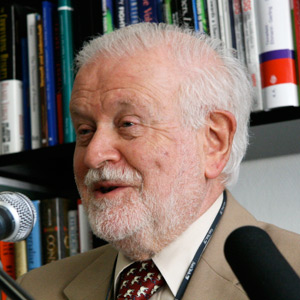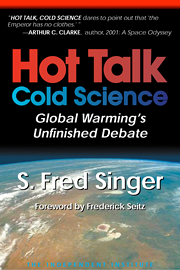The AOH is an ephemeral (every Oct-Nov) thinning of stratospheric ozone at an altitude of 20-25 km, roughly covering the Antarctic continent; unanticipated, it was discovered serendipitously in 1985 but is now tracked with satellite-borne ozone meters. Its discovery created much panic about an epidemic of skin cancers that led directly to passage of the 1987 Montreal Protocol, an international treaty stopping the manufacture and release into the atmosphere of ozone-depleting chemicals, including CFCs used in refrigeration and bromine-containing fire suppressants.
Recently, there have been many voices, suggesting that the AOH is shrinking, presumably as a result of the Protocol. I am somewhat skeptical of the evidence, but also for theoretical reasons. I am inclined to blame wishful thinking—a desire to justify post facto the 1987 Montreal Protocol and the economic losses it has produced around the world since then. By implication also, this tends to support the concept of a (largely unrelated) global climate treaty that would severely reduce the release of the greenhouse gas CO2.
For evidence, I refer to a well-written semi-popular story in Eos of 15 August 2016, which relies mainly on a paper in Science magazine [of 30 June, 2016] by MIT chemist Susan Solomon et al. The credibility of the paper derives from the fact that its lead author had identified the correct mechanism for creating the AOH at a time when there was much dispute about its cause; it turned out to be ‘heterogeneous’ reactions of chlorine compounds on the surfaces of polar stratospheric clouds (PSCs), made up of ice particles created from stratospheric moisture by the extremely cold local temperatures. [Heterogeneous reactions involve both gas molecules and solid particles, while ‘homogeneous’ reactions involve only gas molecules.]
These reactions eventually release free chlorine atoms (able to destroy ozone catalytically) from the existing stratospheric chlorine reservoir, gaseous HCl –hydrogen chloride. The relevant chemical reactions commence when solar radiation reaches the Antarctic stratosphere in the beginning of Spring, i.e., in October, after a winter darkness lasting up to six months.
But the same Eos story also quotes NASA atmospheric scientist Susan Strahan, who points to the difficulty of identifying a trend in the presence of “noise,” the year-to-year variation in geographic extent of the AOH. Worse still, the AOH can also be characterized by other varying parameters, like depth of depletion and by its duration. Nevertheless, Solomon extrapolates the somewhat uncertain geographic trend and boldly estimates that the AOH will seal up and disappear by mid-century.
In the American Geophysical Union journal Earth Future, atmospheric chemist Guy Brasseur and colleagues suggest a faster way to “heal” the AOH – by actively releasing ice particles in the stratosphere to deplete HCl, the main reservoir of stratospheric chlorine. But they do not consider the continued existence of natural sources of chlorine compounds: frequent volcanic injections and possibly also oceanic salt spray carried into the stratosphere by convection. Worse still, they ignore the risks of their proposed geo-engineering scheme—the strong greenhouse effects of their ice particles, which would absorb and then re-emit (albeit at a much lower temperature) most of the outgoing long-wave radiation from earth into space, covering even the normally open atmospheric infrared “window” region (of 8 – 12 microns).
An incipient ozone hole in the Arctic region?
And now to my theoretical doubts. The catalytic action suggests a highly non-linear dependence of ozone depletion on both chlorine and PSC ice particles. I suspect that PSCs are crucial—so that even a small amount of chlorine compounds from natural sources will create an AOH in the presence of some PSCs.
In other words, we may be stuck with an AOH; it will not mend—unless we can raise the stratospheric temperature sufficiently to remove PSC ice particles. But with CO2 increasing steadily and thereby further cooling the stratosphere (as is commonly believed), there is little chance of raising stratospheric temperatures. By the same token, I think it inevitable that an Arctic ozone hole will develop—and quite suddenly—as suggested in a 1989 Letter in Eos. [Yes, including over Kennebunkport, Maine.] The implications of an Arctic ozone depletion are cause for concern: an increase in ground-level (skin-cancer-causing) solar ultraviolet radiation in densely populated regions, in Europe and elsewhere—although attenuated by the large zenith angle of the Sun, as well as by clouds and haze.
All in all then, I am not really optimistic about the future of ozone holes in the Polar regions. The Montreal Protocol may have been chasing the wrong target, in my opinion.
Many failed predictions
The whole ozone story is beset with many failed predictions:
**Starting in 1970, it was widely held that water vapor from the burnt fuel of supersonic aircraft flying in the stratosphere would damage the ozone layer and cause an epidemic of skin cancers. However, it turned out that the real villain (according to Prof Harold Johnston of UCB) would be the catalytic action of trace amounts of nitrogen oxides in the SST exhausts; in its annual reports, the National Academy of Sciences even predicted depletions of up to 70 percent! In any case, the ensuing popular panic forced the cancelation of the US project to construct two SST prototypes.
**Ironically, I soon found (Nature 1971) that rice agriculture and cattle raising (cows) would create growing amounts of atmospheric methane, leading to an increase of stratospheric water vapor equivalent to a fleet of 500(!) SSTs.
**Finally, Cicerone and Stolarski discovered that chlorine would be the most effective destroyer of ozone; Rowland and Molina then published their calculations (Nature 1974) implicating CFCs, which garnered them a Nobel Prize in Chemistry “for contributing to the salvation of mankind” – to quote the Nobel selection panel.
** None of these publications had considered heterogeneous reactions – although it was known at the time that particles injected into the stratosphere by volcanic eruptions greatly enhanced ozone depletion. And so they all missed the AOH –whose discovery in 1985 came as a complete surprise. [Homogeneous (purely gas-phase) reactions are appropriate only in the upper stratosphere, at about 40-50 km, where there is very little ozone to destroy—well above the ozone maximum at 20-25 km.]
**One more irony: in 1987, when the Montreal Protocol was hastily adopted, the observational evidence (of R. Zander et al, JAtmosChem 1987) showed no appreciable secular increase of HCl, suggesting the absence of any significant human contribution to stratospheric chlorine. It was only much later, in 1991, that NASA-Langley scientist Curtis Rinsland published his definitive result, showing steadily increasing hydrogen chloride.
Conclusion
After witnessing all of these missteps and premature wrong guesses, I may be excused for believing that the current excitement about the “healing” of the AOH could turn out to be just another failed prediction.










